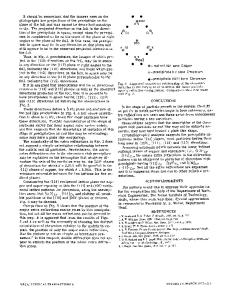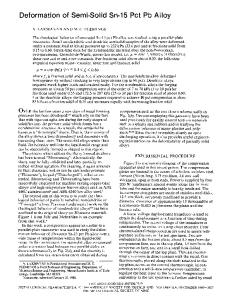Hydride precipitation and dislocation substructures in Ti-5 pct Al-2.5 pct Sn
- PDF / 2,063,394 Bytes
- 5 Pages / 594 x 774 pts Page_size
- 83 Downloads / 309 Views
I.
INTRODUCTION
THREEdistinct hydrides have been
reported to occur in the Ti-5 pet A1-2.5 pet Sn alloy, depending on hydrogen content. 1. )'-hydrides at >330 wppm hydrogen. These have an fcc structure above 37 ~ with a lattice parameter 444 pm; at lower temperatures the structure undergoes a tetragonal distortion, but this is not readily detected by electron diffraction. y hydride precipitates as thin plates on the {10]0}~ planes and with an orientation relationship (0001)oll {001}7;
0 lO) ll(li0).
2. "Type A" hydrides at >510 wppm hydrogen. These occur as thin (50 nm) plates with a high dislocation density; the habit plane is not fixed but has an angular spread about the {10]7}~ plane. The crystal structure is not known. 3. "Type B" hydrides at >600 wppm. These have an fcc structure with a lattice parameter 426 pm and an orientation relationship (0001L II{Ill}fee; (1210)~ II(1]'0)fcc. They precipitate as thin plates on the (0001L plane and may be more correctly described as hydrogen stabilized stacking faults. 2 The occurrence of these hydrides in other titanium alloys depends not only on hydrogen content but also on alloy content and applied stress. In Ti-AI alloys, for example, it has been shown that increasing aluminum content (from 3.3 pet to 6 pet A1) increases the propensity for the formation of basal (Type B) hydrides over y-hydrides; this was rationalized in terms of the increasing tendency for basal slip to occur in preference to prism slip with increasing aluminum content. 3 This argument may be developed further. In the case of the basal hydrides, the structure change hcp ~ fcc (or fct) may be accomplished by the passage of V3(10]'0) Shockley partial dislocations on alternate (0001)~ planes, and the fcc structure is predicted to be in the observed orientation relationship. 4 Similarly, in the case of the y-hydrides, the structure change (apart from appropriate shuffles and lattice expansions and contractions) may be accomplished by the passage of V6(1210) partial dislocations on the {10]-0}~ (habit) plane, and again the fcc structure is predicted to be in the observed orientation relationship. 5'6 Such partials have not been identified but could arise as the result of the dissociation of a type slip dislocations on the {10]'0}~ planes. c. HAMMOND is with the Department of Metallurgy, Universityof Leeds, Leeds, United Kingdom. R.A. SPURLINGis with the Science Center, RockwellInternational, 1049Camino Dos Rios, ThousandOaks, CA 91360. N.E. PATON is with RocketdyneDivision, Rockwell International, 6633 Canoga Avenue, Canoga Park, CA 91304. Manuscript submittedJanuary 25, 1983. METALLURGICALTRANSACTIONSA
The occurrence of hydrides of any type is important, particularly with regard to those properties which are dependent upon the initiation and propagation of cracks under the conditions of sustained load cracking, slow crack growth, stress corrosion, and low cycle fatigue. (The subject has been reviewed by Paton and Williams, Reference 7.) The object of the present investigation was to establish whethe
Data Loading...











